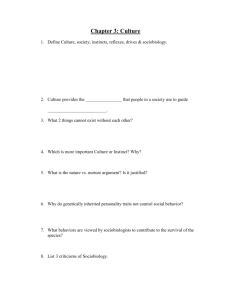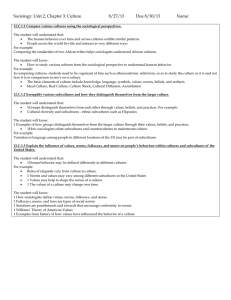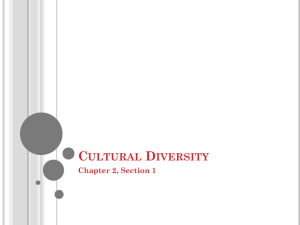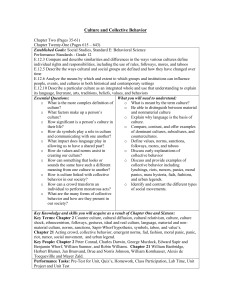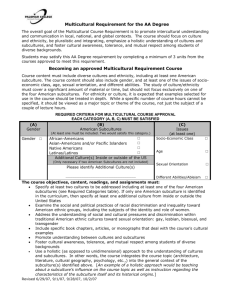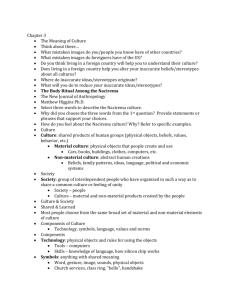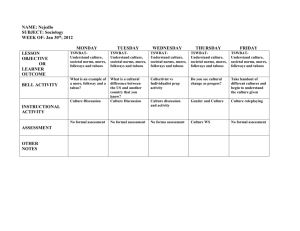2.1
advertisement
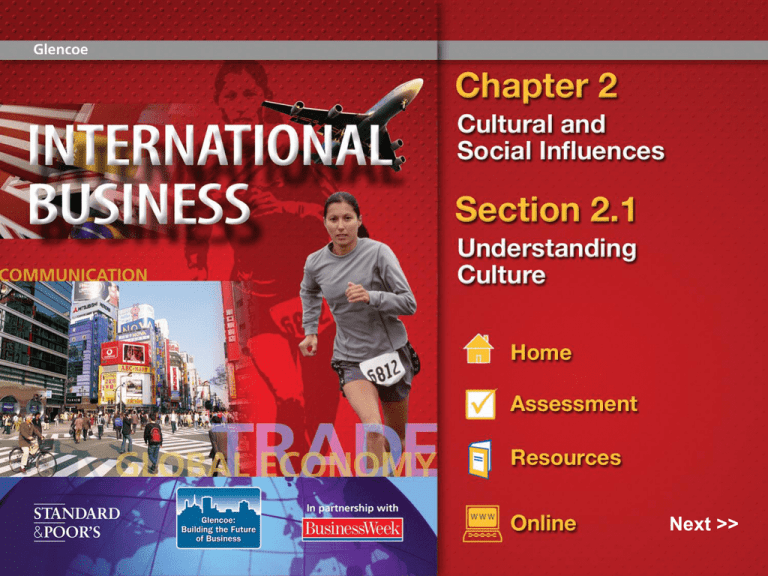
Next >> Understanding cultural differences can help promote good global business. 2 To explain how culture affects international business To describe the elements of cultures To describe the elements of subcultures 3 Understanding culture and its effect on international business provides a foundation for working in the global community. 4 culture the set of beliefs, customs, and attitudes of a distinct group of people values strongly held concepts that are present in culture 5 norms social rules that affect behaviors and actions, and represent cultural values folkways and cultural customs that dictate how mores people act socially 6 role the part a person plays in a social situation subculture a smaller group or subset within a larger culture 7 Culture in International Business The cultures of two trading partners can affect a business relationship. Understanding culture is the foundation, or basis, of understanding every other aspect of conducting international business. 8 Understanding Culture Each level of culture— national, regional, or local—has an impact on the lives of people who live on that level. culture the set of beliefs, customs, and attitudes of a distinct group of people 9 Understanding Culture 10 Understanding Culture Succeeding in the world of international business requires three things. 1 2 3 Understanding Culture Preparing for and adjusting to culture Participating in culture 11 12 Elements of Culture Values Norms Four Elements of Culture Roles Folkways and Mores 13 Elements of Culture Values are connected to powerful emotions. For example, in the United States, many people value freedom. values strongly held concepts that are present in a culture 14 Elements of Culture Norms may reflect values. In some cultures, the norm may be that women walk behind men in public. norms social rules that affect behaviors and actions, and represent cultural values 15 Elements of Culture Some folkways and mores may be minor, while others have a major impact on people’s lives. folkways and mores cultural customs that dictate how people act socially 16 Elements of Culture Mores are customs that reflect moral standards in a culture. Mores are strongly held by a group and can influence controversial political topics. 17 Elements of Culture The role you play is influenced by your community. role the part a person plays in a social situation You play many roles each day. 18 Elements of Culture Examples of roles include: Son or daughter Friend Employee Student Spectator Citizen 19 Factors that Create Roles 20 Value Dimensions of Culture Power Distance Short-term or Long-term orientation Value Dimensions Uncertainty Avoidance Individualism or Collectivism Gender Differentiation 21 Value Dimensions of Culture In cultures with a large power distance among individuals, supervisors are “always right.” 22 Value Dimensions of Culture In individualistic countries, people tend to take care of themselves and immediate families first. Examples include the United States and Australia. 23 Value Dimensions of Culture In cultures with a high degree of gender differentiation, men tend to dominate society and power structures. Examples include Middle Eastern countries. 24 Value Dimensions of Culture In high risk-avoidance countries, managers are less willing to take risks. Examples include Mexico, Portugal, and Japan. 25 Value Dimensions of Culture Relate In what ways might your personal values be influenced by living in an individualistic country? 26 Value Dimensions of Culture The United States is an example of a country with a short-term orientation. Many Asian countries believe that placing importance on short-term results causes a company to ignore long-term results. 27 Understanding Subcultures People with varied behaviors within a culture make up a subculture. subculture a smaller group or subset within a larger culture Subcultures can form around sports or other interests. 28 Understanding Subcultures A key to working in international business is to be aware that people within the same nation and/or business organization may be quite different. 29 Understanding Subcultures Recall What are subcultures and why is recognizing them important? 30 Single Culture and Multicultural Countries A homogeneous culture is one in which one group of people is dominant in the population. A homogeneous culture exists in a single-culture nation or region. 31 Single Culture and Multicultural Countries The United States is heterogeneous in a multicultural country, where there are many different groups of people. 32 Multinational Companies Because a multinational company includes cultures from several nations, business decisions may be more inclusive and targeted to the variety of cultures. 33 2.1 1. What cultural elements create individual roles in society? values, norms, folkways and mores, customs, educational systems, religious organizations, gender roles, class systems, and degrees of mobility 34 2.1 2. What are some examples of dimensions of culture? power distance, individualism or collectivism, uncertainty avoidance, and short-term or long-term orientation 35 2.1 3. What is the definition of the term subculture? a smaller group or subset within a larger culture 36 End of
